A walk down Avenida de Mayo is essential for any visit to Buenos Aires.
It is easily one of the most beautiful streets in the city and while you’ll likely visit it during you stay, I argue that you should walk the entire length (it really isn’t that long, you can do it!).
Inaugurated in 1894, Avenida de Mayo is the oldest avenue in Buenos Aires.
It was planned with Parisian boulevards and Madrid’s Gran Via as inspiration.
Like most things in Buenos Aires, this progress required the destruction of buildings already in place and it was met with some understandable feedback. But once in place, it wasn’t long before Avenida de Mayo was the center of aristratic life and culture.
Today, to walk down this historic avenue is to walk through the historical Paris of South America.

QUICK NOTE: This post contains affiliate links and Sol Salute may receive a commission for purchases made through these links, at no extra cost to you.
Self-Guided Walking Tour of Avenida de Mayo
This self-guided walking tour highlights the must-see attractions along Avenida de Mayo.
The route holds significant political importance, connecting the Presidential seat to the Congress.
On inauguration day, new presidents are sworn in in Congress then travel directly to the Casa Rosada.
Major protests also travel this avenue, taking their complaints to the top political powers.
More Walking Tours:
While you’re exploring, don’t miss my other self guided walking tours and neighborhood guides. The links below will open in a new tab so you won’t lose this one!

How long does this downtown Buenos Aires walking tour take?
It’s not a long walk and if you were to treat it like a relaxed stroll – stopping for a coffee and the occasional photo – you could do it all in an hour to an hour and a half.
Personally, I’d plot out half a day for it to allow time to visit museums.
In which direction should I go?
This route connects the Plaza del Congreso to Plaza de Mayo.
You can easily and obviously walk Avenida de Mayo in either direction, but which makes the most sense?
Start in Plaza de Mayo if… you’re going to do this in the afternoon. Then you can visit the Palacio Barolo at sunset afterwards. This building by Congress has incredible views. Go on a guided tour for sunset (plan on going to the one that starts one hour before sunset) or book a table at their Salon 1923 roof bar for a sunset drink.
Start in Plaza del Congreso if… you’re going in the morning and want to easily fill the afternoon with activities afterwards. By ending in Plaza de Mayo you can easily walk into Puerto Madero or San Telmo, or take a quick taxi to La Boca.
I’m starting this guide from the Plaza del Congreso, let’s go!
Map of Avenida de Mayo

Argentine National Congress
Begin in front of one of the most impressive buildings in the city, the National Congress.
You can get here with the subte Line A to the Congreso stop.
Construction began on the palace in 1897 and the building was finally inaugurated in 1906 but not without drama.
The original architect, Vittorio Meano was murdered in his home in 1904. Belgian architect Julio Dormal finished the project, respecting the original plans.
The building was dubbed the “Golden Palace” by journalists due to the budget-busting costs, ringing up to over 31 million pesos in 1914.
After admiring the costly Congress, take a stroll through the Plaza del Congreso towards Avenida de Mayo.
Guided tour of Congress → You can go on a guided tour of the Congress via the Senate (Senado) or the House of Representatives (Cámara de Diputados). Each have different entrances and start times but you’ll see virtually the exact same thing on both, so pick the one whose timing works best for you.

Plaza del Congreso
All roads begin here. The zero kilometer marker for all of the country’s highways is located here.
And one of the bordering streets, Rivadavia Avenue, actually divides the city in two.
The roads branching off of Rivadavia have different names on either side. For example, you may drive down Avenida Callao to get here but once you cross Avenida Rivadavia you are now on Entre Rios Avenue.
📸Look for Rodin’s The Thinker in the center of the square, the third of only eight original casts made.
Walk through the square until you’re at Avenida de Mayo, walk a block to Palacio Barolo.
Read Next: The Best Things to do in Buenos Aires


Palacio Barolo
📍Avenida de Mayo 1370
The building was designed by the architect Mario Palanti and financed by Luis Barolo, both Italians. The building is loaded with symbolism from Dante’s Divine Comedy.
The ground floor gallery is hell, filled with demons holding light fixtures and 9 arches representing the nine circles of hell. Floors 1-14 represent purgatory and 15-22 is paradise.
Book guided tours of Palacio Barolo here or go up to their terrace bar Salon 1923 (make a reservation).
SUNSET TIP → This is my favorite spot for sunset. You can take the guided tour for it by going on the tour that starts one hour before sunset, check your weather app. For a sunset cocktail, make a reservation at Salon 1923 or at next door at Dome (Hotel Tango de Mayo’s rooftop bar, open seasonally).

Los 36 Billares
📍Avenida de Mayo 1271
This traditional cafe bar is as old as Avenida de Mayo itself having also been inaugurated in 1894. Today the building houses the Hotel Marbella.
Los 36 Billares occupies the entire ground floor and basement of a French academicist style apartment block. Its most known for its basement and billiards tables.
There are still 8 original billiards tables that are more than 120 years old and 9 professional tables.
Not into playing pool? There is more history than billiards here. Federico García Lorca frequented this cafe, among other writers.
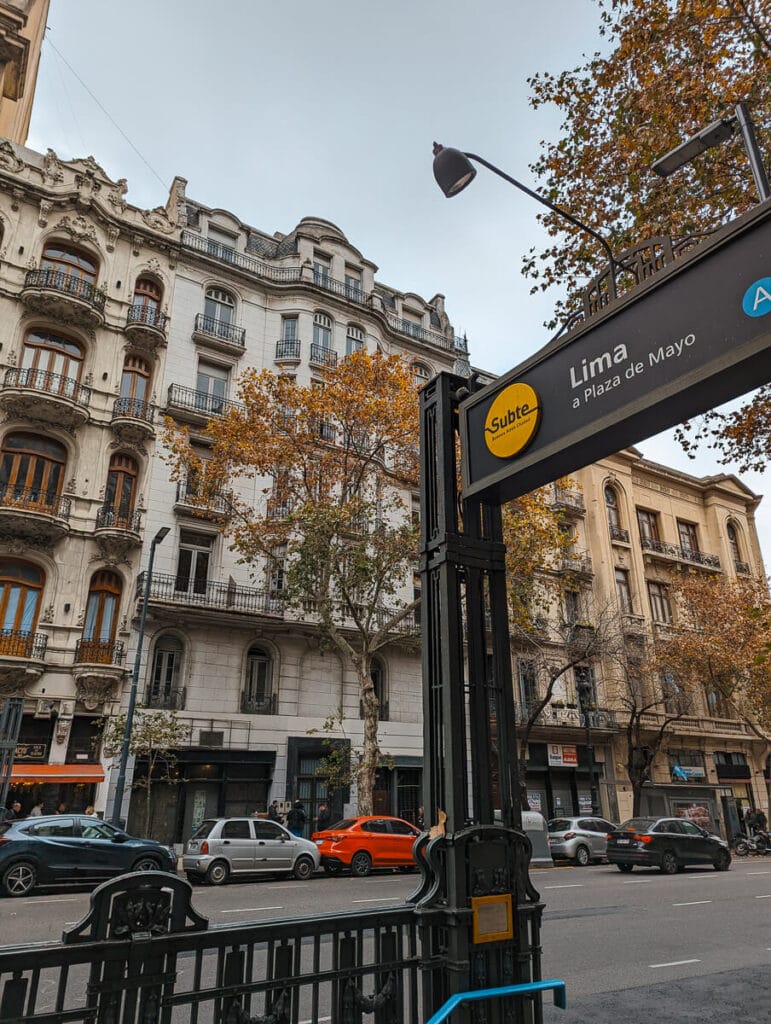

El Teatro Avenida
📍Avenida de Mayo 1222
Just across the street from Los 36 Billares is the most emblematic theater of Avenida de Mayo, El Teatro Avenida, open since 1908.
Throughout the theater’s early years this was the hub of the Spanish immigrant community, who brought with them traditional genres like zarzuela.
And remember the mention of Federico García Lorca frequenting Los 36 Billares? He was here because Spanish actress Lola Membrives dedicated an entire season at the theater to performing his works.
He came to Buenos Aires in October of 1933 to see his work performed here and spent 6 months in the neighboring Hotel Castelar.

Cross 9 de Julio
Admire the architecture until you get to 9 de Julio, the worlds widest avenue.
The avenue is named after Argentina’s Independence Day: July 9, 1816.
The avenue is the widest in the world with 7 lanes going in each direction, however, it’s only about 1 kilometer in length.
You can take a quick detour to the Obelisco and Teatro Colon from here if you’d like.
In the opposite direction you’ll see a skyscraper bearing a metal portrait of Evita, one of the most attention catching Evita sites in Buenos Aires.
She’s depicted yelling into a microphone, almost aggressively. This portrait faces the wealthier northern side of the city – her opposition.
On the other side of the same building is a docile, peaceful portrait which faces the working class southern neighborhoods – her supporters.


Have a Coffee at Cafe Tortoni
Rest your feet with a coffee break at Cafe Tortoni at Avenia de Mayo 825.
Open since 1858, stepping into Tortoni is like traveling back in time. Literally, this is the oldest cafe in Buenos Aires.
Sit in the same cafe as Jorge Luis Borges and Julio Cortázar to enjoy a cortado (coffee with a splash of milk).
You can even visit at night for a tango show, at night check out one of the best Buenos Aires tango shows in their back room.

Tortoni Alternative? → You can make a detour 3 blocks to Confiteria La Ideal, founded in 1912. It’s another decadent historic cafe that, if I may say so, is more impressive than Tortoni. It’s larger, even more opulent, and the quality of the food is better. See my reel of it here for proof.
From Cafe Tortoni, slowly stroll down the next three blocks to Plaza de Mayo.
Enjoy the tree-lined sidewalks and the gorgeous architecture, don’t forget to look up. The architecture here is impressive!
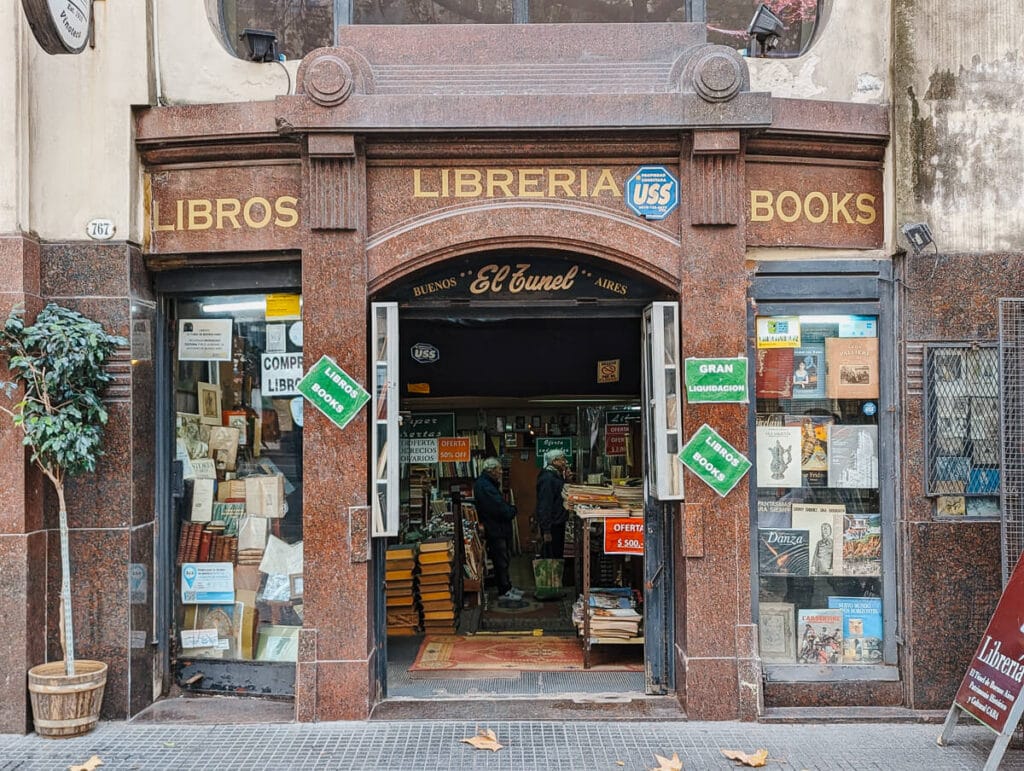
Shop for Books in El Tunel
At Avenida de Mayo 767, step into the El Tunel bookshop.
Buenos Aires is full of bookshops, there are more bookstores in Buenos Aires per capita than any other city in the world.
People here love to read, and contrary to the US where bookshops are closing at a rapid rate thanks to the kindle, bookstores here are thriving.
Duck into El Tunel to hunt for treasure amidst the piles and shelves and boxes of books.
Leather bound, paperback, or random old magazine – you’re sure to find something to bring home.

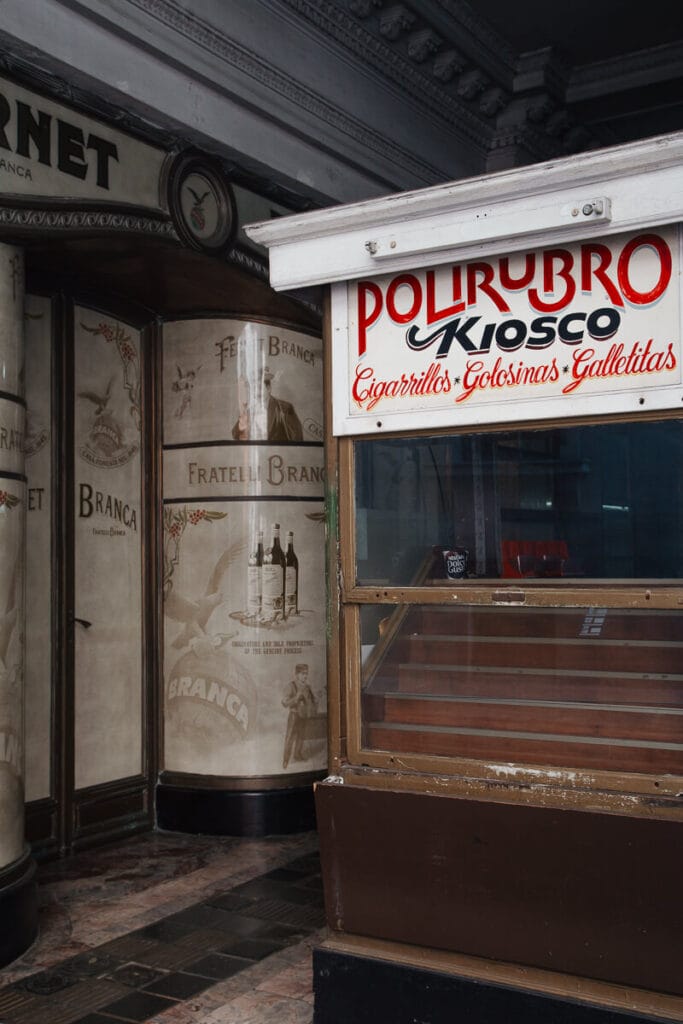
Pasaje Roverano
📍Avenida de Mayo 560
I love the galerias of Buenos Aires and Pasaje Roverano is the most beautiful of all.
The gallery was built in 1878 but remodeled when they begun construction on Avenida de Mayo.
It joins Avenida de Mayo and Hipólito Yrigoyen. The windows to the shops are curved, intricate with bronze details. It’s beautiful and I hope the entire space is revitalized at some point, it deserves more life.
Look for the hair salon, their claim to fame is being the hair salon of Pope Francis during his time as the archbishop at the neighboring Metropolitan Cathedral.


Cabildo
When you arrive at Plaza de Mayo, on your right you’ll see the Cabildo.
The Cabildo was the center of the Spanish Government when Argentina was under colonial rule.
The original adobe structure was built in 1580, and the white stucco building you see dates back to 1810.
Inside is a history museum and I find it really worthwhile. Entrance is free of charge, so you have no excuse.
Whether you spend a while reading the plaques or fly right through, make sure you head up to the second story balcony for a great view of Plaza de Mayo and the Casa Rosada.
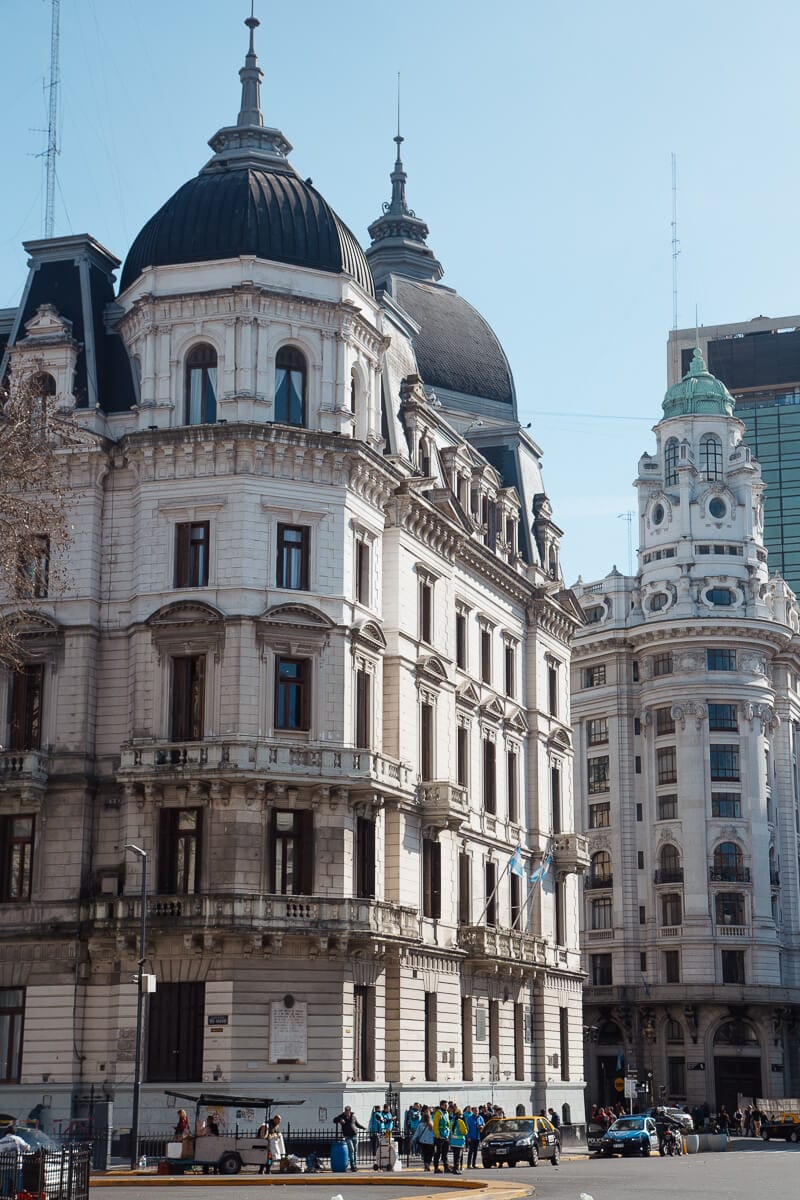

The Metropolitan Cathedral
Catty corner from the Cabildo is the Metropolitan Cathedral.
When you reach the corner of the plaza to walk to the cathedral’s entrance, you’ll cross Avenue Diagonal Norte with a great view of the Obelisk on 9 de Julio.
It may look more like the Pantheon or a Greek temple, but this is indeed the main cathedral of the Catholic Church in Argentina.
There has been a church on this location since 1593 under orders from the city’s founder Juan de Garay.
After 7 re-builds, the current structure we see today dates back to 1752.
Outside the entrance burns the eternal flame for the unknown soldier and General San Martin.

Mausoleum of General San Martín
The Mausoleum of General San Martín is a must-see.
It is in the third chapel to the right of the central nave.
The three women standing guard at the base represent Argentina, Chile, and Peru: the three countries liberated by San Martín.
There are two soldiers, grenadiers, standing guard outside the entrance to the chapel.
We were lucky enough to catch the changing of the guard at 3 pm. You can see that for yourself every two hours on the odds.
Read More: The Perfect 3 Days in Buenos Aires Itinerary

La Pirámide de Mayo
This is the first patriotic monument in Buenos Aires. Talks began in 1811 but it wasn’t until 1912 that it was finally placed where you see it today – in the center of the Plaza de Mayo.
The history surrounding this monument could (and probably does) fill a book, so I recommend a proper guided tour if interested in diving deep.
During the 1970’s military dictatorship, gathering in groups was forbidden.
The Madres de la Plaza de Mayo, protesting and demanding the return of their missing children, “obeyed” these “rules” by walking laps of this momument.
Slowly marching they called the names of their disappeared loved ones.
Ever since 1977, the mothers march every Thursday at 3:30 pm.

Casa Rosada
The Casa Rosada houses the executive branch and the presidential office.
The president doesn’t reside here. They have an official residence in the northern suburb, Olivos.
But this is where the magic happens, where they work every day, and where Madonna – as Evita – tells Argentina not to cry for her.
No one knows for sure why the building has always been painted pink.
Two main theories include political parties and lard. The first being that the two colors of the main political parties blended together to create pink.
The second referencing the proximity to the river. To protect the building from humidity, a mixture including lard was painted onto the walls, and that lard had traces of blood in it, giving these pink tones.
Guided tours of the Casa Rosada – I went on this tour back in 2018 and they stopped in 2020. Supposedly, they’re happening again but the website you need to reserve on does not work. Typical. (If you’ve found a functioning link please comment below). They also provide this email address, give it a shot. Tours only happen on weekends & holidays from 10 am – 6 pm and you need your passport for entry.
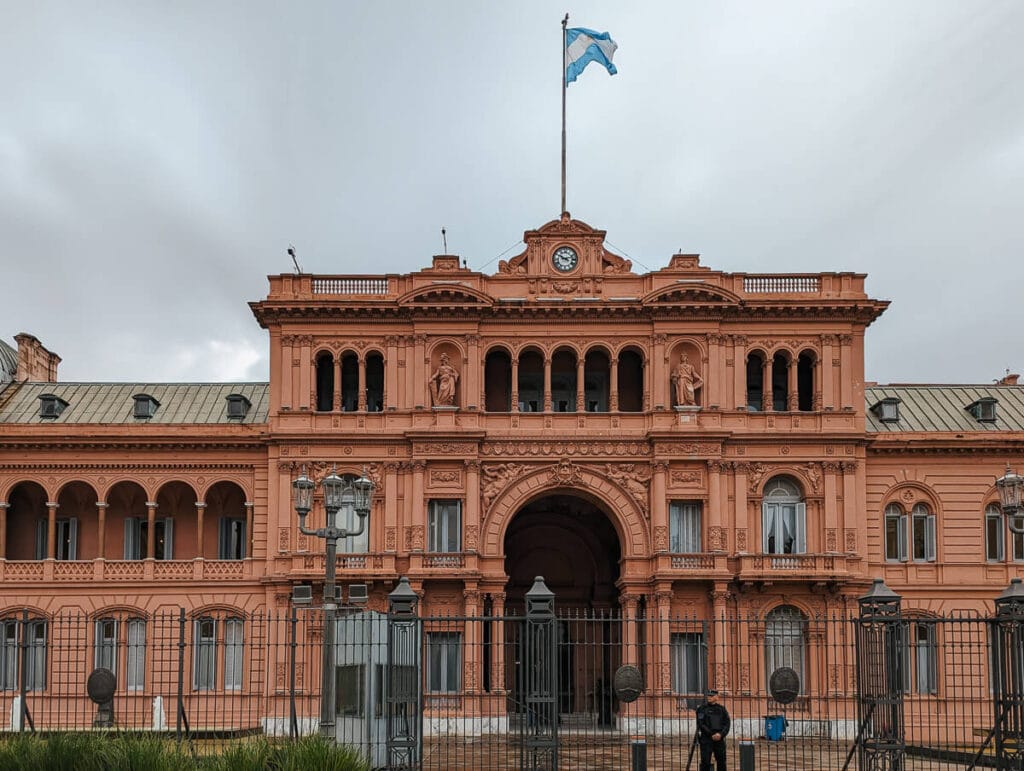
What to do nearby
Thanks for taking this walking tour of Avenida de Mayo with me!
Here are some options on how to continue your day from Plaza de Mayo:
- Explore San Telmo. If you’re in Plaza de Mayo, head south on Calle Defensa, read my San Telmo guide for tips.
- Go on a Buenos Aires bike tour, my favorite bike tours depart from San Telmo. Spend the early morning walking Avenida de Mayo and the afternoon biking the city!
- See Puerto Madero. Walk around the Casa Rosada, behind it is a pedestrian path and staircase leading down to the modern waterfront. Tango performers are often in the street and you can see the famous Puente de la Mujer. (But I typically avoid eating here as most restaurants lack much character and are overpriced).
- If you’re enjoying the museums and architecture and want more of that, then I recommend visiting the nearby Kirchner Cultural Center located in the city’s original post office.
- Or hop in a taxi to La Boca!
I already discussed this earlier in the article, but if you’re ending this tour in the afternoon, see the sunset from Palacio Barolo!
And whatever you choose, definitely end the night with a steak at one of the best Buenos Aires steakhouses and a glass of Malbec.
Where to stay on Avenida de Mayo
Want to stay downtown? I recommend basing yourself here if you’re on a short trip. You’ll see a lot in a short amount of time.
Here some beautiful properties on Avenida de Mayo:
- Hotel Tango de Mayo | Great location next door to Palacio Barolo, steps from the Congressional Plaza and a number of restaurants. The rooftop bar, Dome, is one of my favorites for a view (open in Spring & Summer).
- Parla Hostel | On a budget? This is a great hostel in the heart of downtown, just one block off of Avenida de Mayo. Tons of sleeping options, a large common area, and close to the subte.
- For more options, read my complete guide on where to stay in Buenos Aires
Argentina Travel Resources
- BOOK A CONSULTATION | I offer one-on-one travel consultations to help you plan your trip to Argentina. Pick my brain to get a local’s insight. Click here for more information.
- MY MAP | Buy my interactive map with 300+ pins to have access to the city as I see it. It is an invaluable resource. See more here about how it works.
- AIRPORT TRANSFERS | Having a driver waiting for you is ideal for a stress free arrival, Welcome Pickups is the best option for a driver from Ezeiza or Aeroparque.
- TRAVEL INSURANCE | Always travel insured. Anything can happen anywhere and it is scarier and costlier in an unfamiliar country. SafetyWing’s Essential Plan covers unexpected travel and medical emergencies and even offers add-ons like electronics theft or adventure sports. It is the best if you’re coming on vacation. If you’re coming as a digital nomad or an extended stay, you need their Complete Nomad Plan which also covers routine check ups, maternity, mental healthcare and more. Read more: Health Insurance in Argentina
- PHONE PLAN | These days, traveling with data is essential. Especially in Argentina where everything is managed on Instagram and WhatsApp. I recommend this E-SIM card. It’s hassle-free and affordable, for more read how to get an Argentina sim card.
- ACCOMMODATION IN ARGENTINA | booking.com is the most common hotel site used in Argentina and it’s where you’ll find the most options.
- RENTAL CARS | I love to travel Argentina via road trip, Discover Cars is a great platform to compare different rates and providers.
- BUS TICKETS | Check Busbud for long distance bus routes and tickets.
- VPN | If you’ll be using a public WiFi connection and want to secure your data, I highly recommend using a VPN, I personally use and have had a good experience with ExpressVPN. I also use it to access Hulu and American Netflix from Argentina.
- FLIGHTS | Always check Google Flights and Skyscanner for flights to and within Argentina. Aerolineas Argentina is the local airline with the most routes. FlyBondi and Jetsmart are two budget airlines with dirt-cheap prices (but expect to pay for every add-on like luggage).


